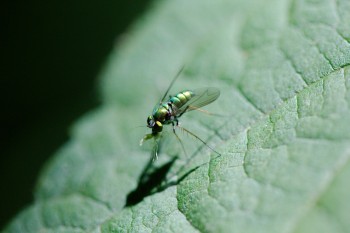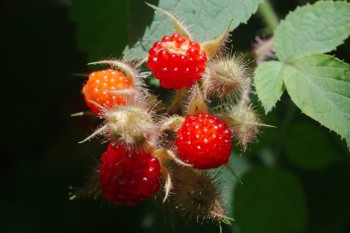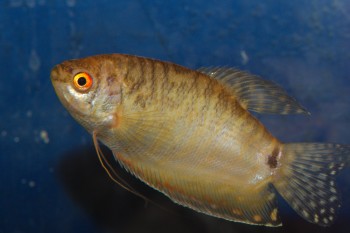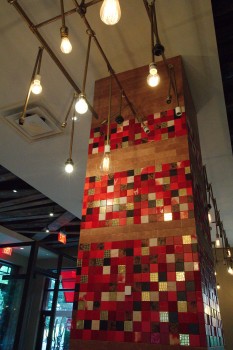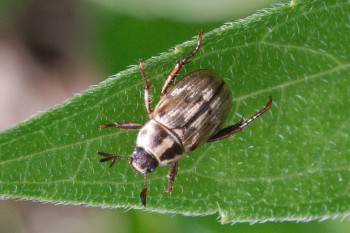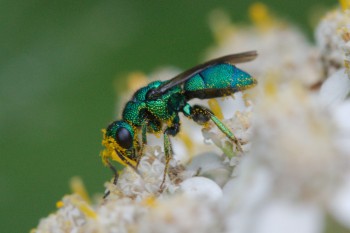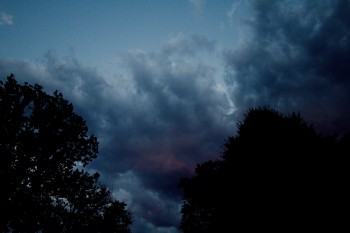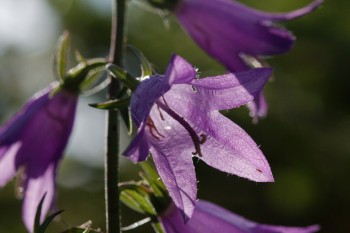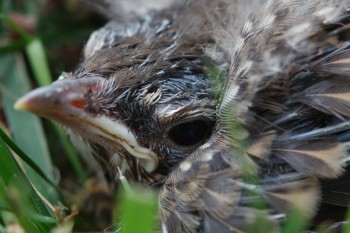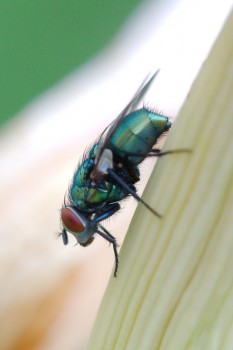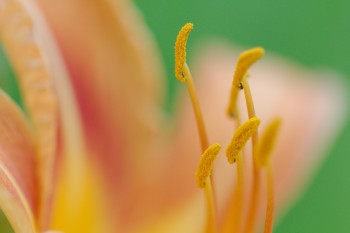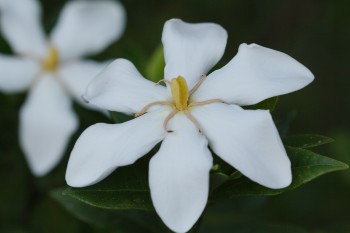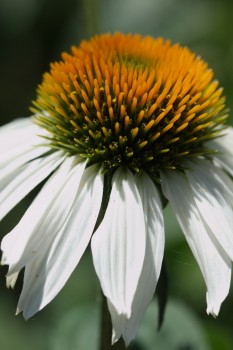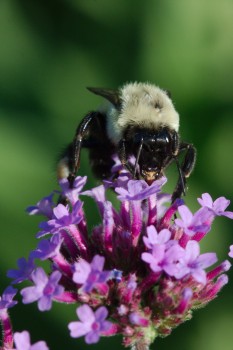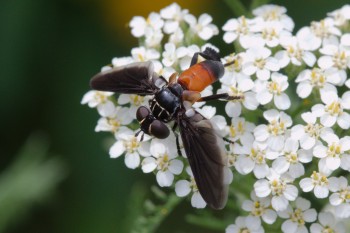While I was out picking raspberries I saw a spider web with an orchard orbweaver spider (Leucauge venusta). I took a few pictures but it was too dim and I didn’t have my tripod so I wasn’t able to get enough depth of field to make the image worth sharing. I also saw this little fellow (or lady, I really don’t know). The leaf it was on was moving in the slight breeze and of course there’s that “hand-held” thing, so most of the pictures were out of focus or blurred. This one, I think, is pretty good. Fortunately it was in a small ray of sunshine giving me enough light for a reasonably short exposure. It is one of the flies in the genus Condylostylus but many of them look quite similar, so I don’t know which one.
Wild Raspberries
I found a great patch of wild raspberries today and enjoyed about a pint of them before moving on. It’s all I had for lunch today, but it was a pretty sweet lunch. I think I’ll come back with a container and collect more in the next couple of days.
You’ll forgive me if I don’t mention where this patch happens to be located. There are a lot of berries but not enough, I’m sorry to say, to share with too many others. I’ll be watching to see if I’m followed.
Independence Day, 2013
We decided to walk with Albert and Brady to see the Rockville fireworks this year. As it turns out, we stopped walking a bit sooner that we probably should. Ralph and Tsai-Hong went on and saw them much more closely than we did, although we got a reasonable view. We were a bit surprised at the brevity fo the show. Well, it turns out that it was due to a technical fault. The City of Rockville put out the following notice:
Due to technical difficulties, the annual Rockville Independence Day fireworks show was shorter than anticipated.
The show, planned to be about 20 minutes, experienced technical difficulties about six minutes after it started.
Unable to diagnose the problem, the fireworks technician made the decision to move directly to the show’s three minute finale, which was unaffected.
Thank you to everyone who attended. We will be working with our fireworks vendor to do everything possible to avoid this from occurring in the future.
Still, considering how little effort we went to, the show was fine and we were with family and good friends. You really cannot ask for much more than that.
Golden Three-spot Gourami (Trichopodus trichopterus)
In addition to the pictures I took of Cathy and Dorothy (see prior post), I took a few pictures of our fish. We recently acquired a few new fish from one of Dorothy’s friends, whose family is moving to Colorado. This is a golden gourami, which is one of the common color morphs of the three-spot gourami, Trichopodus trichopterus, native to southern China, Vietnam, Laos, Cambodia, Thailand, Burma, and Malaysia. This is a pretty good size specimen and has adapted well to our tank, along with a large angel fish, some neon tetras, and a pretty good sized plecostomus.
Cathy and Dorothy
It was about 10:30 this evening and I hadn’t taken any pictures today. I asked the girls if I could take there picture and I took about a dozen. This one turned out quite well, I think. Others had one or both of them making silly faces, and while they are funny, it’s easy to get tired of silly faces and I don’t think I’ll ever get tired of their ordinary smiles.
I love you both, girls.
Surgery Follow-up
As followers of this blog know, I had surgery in May and then again on June 12, just under three weeks ago. I was back in to have the staples removed last week and went in again today for what we all hope will be my last visit. I’m recovering nicely, although I’m still supposed to take it easy.
I don’t like telling people that I hope never to see them again, but when the reason you see them is that you need or are recovering from surgery, that’s a little different. Viki, the nurse at this particular doctor’s office, is very nice and cheerful and was gracious enough to let me take a couple pictures of her, after I told her why I carry my camera everywhere. Thanks, Viki, for making a bad time more pleasant.
Nando’s Peri Peri
I happened to be in Bethesda this evening and ran some errands before finding a place to get a quick dinner. There are lots of choices in terms of eating establishments but most of them would probably have taken longer than I had time for. Nando’s Peri Peri looked like it was just what I wanted. It’s name is a misspelling (I assume intentional for trademark purposes) of piri piri, the Portuguese hot sauce made with African bird’s eye chilis (Capsicum frutescens) and often containing some or all of the following: citrus peel, onion, garlic, coriander leaves (cilantro), salt, pepper, lemon or lime juice, paprika, pimiento, basil, oregano, and tarragon.
I found the decor of the place interesting and I took a few photographs with my camera sitting on top of my camera bag to hold it steady in the dim light of evening (and it was raining outside). This column in the middle of the restaurant is covered with beautiful, brightly colored tiles. It turns out, though, that they are not ceramic, as I first thought. They are made of colored leather. I also liked the assortment of incandescent light bulbs. Somehow, compact fluorescent lamps wouldn’t have given the same feel. I wonder where you have to go to get those. They’ll probably be a black market item, soon.
The chicken was delicious, by the way. I got it “hot,” which I recommend.
Anomala orientalis (Oriental Beetle)
I was trying to photograph a particularly small bee this afternoon and not having a lot of success. First, it was only about 5mm long. Second, it kept hiding behind bits of the flower it was on. Third, it kept turning so all I could get was pictures head-on.
Anyway, I happened to notice this little beetle (about 10mm long) on a leaf and decided it would be an easier subject. It is an oriental beetle, Anomala orientalis, and is considered to be a pest. The larvae feed on grass roots, so they aren’t something you want to encourage. I do think the –winged— antennae are cool. The scientific term for that form is flabellate, meaning fan-shaped.
Chrysidinae (Cuckoo Wasp)
This is, I’m pretty sure, a cuckoo wasp (family Chrysididae) in the subfamily Chrysidinae. All of the species in that sub-family have metalic green, blue, or in once case red exoskeleton. They are easy to spot but not always easy to photograph, this is pretty good but I’m still hoping for something sharper. They are not very big, only about a centimeter long, and my lens doesn’t focus any closer than a foot. Maybe it’s time I invested in a set of extension tubes. Of course, they little things don’t stop moving, either, which is a significant issue. The yellow in this picture is pollen from the yarrow (Achillea millefolium) on which the wasp is perched.
Monarda (Bergamot)
The bergamot flowers in our back garden provide a nice splash of red that’s quite obvious from the house. As you get closer you might notice a small swarm of tiny flies around them. The flies land on the flowers occasionally but are easier to see when they land on the leaves. Even then, it’s hard to get close enough to capture them very well. In addition to insect pictures, I also took a few of the flower parts. The cluster of flowers in the bergamot (Monarda) head blooms over time. In this picture, the flowers in the center are finished and the flowers around the rim, with their bright red petals, are in bloom.
Dramatic Sky
It was a very changeable day today, with heavy clouds and impending rain. It did rain a few times but never for very long. We were in Bethesda with some good friends this evening and got back to their house just as the sun was going down. The clouds, which were quite dramatic, parted and exposed some clear sky. This picture was taken looking almost straight up between a pair of trees. There wasn’t much color to the sunset but just a tinge in these clouds.
Campanula
More insect pictures today, but I think this one of Campanula flowers is nicer and we haven’t had as many flowers lately. I got more pictures of the green blow fly but nothing significantly better than what I’ve already posted. I also took some pictures of a small spider of unknown type. I think it might be a lynx spider of the species Oxyopes aglossus, but the picture wasn’t really good enough to be sure. Anyway, this is a nice picture of a pretty little flower, don’t you think?
Bird In The Grass
When I picked Dorothy up from her friend’s house this evening, I got out of the car to chat for a bit before we left. As we were talking I noticed this bird in the grass of the front yard. I’m not sure what sort of bird it is and to be honest, I didn’t pay that close attention. I did get my camera and took a few pictures of it, though. Poor thing probably came out of a next in the tree overhead. It must have been there for some little while, as it was nestled down into the grass quite comfortably. Still, I don’t give too much for its chances. A bird that cannot fly is easy prey for a neighborhood cat.
Genus Lucilia
The mountain mint (Pycnanthemum muticum) is just starting to bloom and there was a wasp or a fly or two flitting about. This is some species of blow fly (Family Calliphoridae) and I think it’s in the genus Lucilia. Most people don’t like flies much and I suppose they have good reason.
Still, many of them are beneficial in one way or another, even if that way happens to be helping recently dead things get broken down into a less offensive form. Blow flies are scavengers and lay their eggs in carrion, which sounds nasty but it’s better than having smelly carcases lying around for days.
On the other hand, blow flies are also one of the main families of flies causing myiasis in livestock and occasionally in humans. If you think laying eggs in carrion is gross, you don’t want to know what myiasis is.
Hemerocallis
It was quite warm today, around 95°F (35°C) but thanks to modern technology, specifically air conditioning, we can remain in cool comfort when needed. When I got home, however, I went out back to see what critters were about. I’ll post an insect photo separately.
The smaller day lilies have been blooming for some little while now but the larger varieties are just getting started. This is a semi-abstract image of one of them. Hemerocallis combines two Greek words which mean “day” and “beautiful” alluding to the fact that the flowers, which are quite beautiful, last but a single day.
Hardy Gardenia
Dorothy spent the afternoon at her grandma’s house today, doing some of her summer reading (Brave New World) and getting some rest after a week at camp. When I went to pick her up in the evening I took a few pictures of the hardy gardenia growing in mom’s front yard. I wish I could have recorded the fragrance for you. It can be almost overpowering but it’s such a lovely smell that it’s hard to care. I brought a few home and put them in the kitchen and we’ve been enjoying them here.
Ben, Michelle, and Their (Lovely) Family
It’s hard to believe it’s been two years since we saw these lovely folks but when they were here last they were just under a month away from having their second child and now here they are with three! What a wonderful time we had catching up, hearing stories, and reconnecting. And what a beautiful family they are becoming. Lilias is becoming quite the little lady and Yan is cute, if somewhat wary of strangers. Thank you all for giving us a day of your time and God bless you as you follow him.
Echinacea purpurea ‘PowWow White’
I did take some more pictures of bees today but they are enough like yesterday’s picture that I won’t bore you with them. We happened to stop at the American Plant Food garden center on River Road today. While Cathy shopped, I took a few pictures, both of bees and of flowers (and sometimes both, obviously). This is a coneflower that, despite it’s specific name, is not purple. At the variety name indicates, it’s white. I do like coneflowers.
Their generic name, Echinacea comes from the Greek word meaning “sea urchin,” from the appearance of the center of the flower. What you might consider to be their petals are actually bracts surrounding the compound flower or inflorescence. The bracts tend to get chewed up a bit by insects so it’s sometimes hard to find particularly photogenic examples. This one, however, is quite nice and I very much like the pure white bracts.
Bumble Bee on Purple-top Vervain
More insect pictures today. It’s starting to be bug time. Most of the bees I’ve been seeing are bumble bees (Bombus sp.). There are a lot of them on the gooseneck loosestrife (Lysimachia clethroides) but this photo is of one on the purple-top vervain (Verbena bonariensis), growing in the middle of our back yard. It used to be in the bed around two trees but the trees are gone now and we’ll see how it does with the extra sun.
Actually, as I look out back now, I see the curved outlines of that bed and think it might be just about the right shape and size for a significant water feature — part pond and part bog garden. That’s not going to happen before fall, but it might happen eventually. I’ll probably want to wait a year for the major roots to rot out a bit, then it should be a lot easier to dig there. I have at least one other design, though, and I’m not sure which I like better. So, we’ll have to see what happens.
Trichopoda pennipes (Feather-legged Fly)
I went out again today, hoping to get a better picture of a snipe file like the one I bagged yesterday. I did see both snipe and syrphid flies and got some pictures but nothing significantly better than yesterday’s. This is a feather-legged fly, Trichopoda pennipes and I’m pretty happy with the picture.
This is another friendly insect and they are actually used in the control of stink and squash bugs. Considering how many stink bugs we have had the last few years, this is someone I’m very happy to have around.

